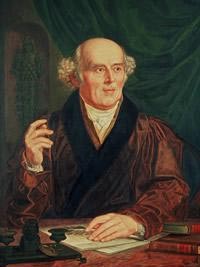 Homoeopathy is a scientific system of medicine founded by the celebrated German physician Dr. Samuel Hahnemann (1755-1843). It is based on the application of the law of similar, which states that “a substance that causes, in a healthy person, symptoms similar to those of a disease state, can cure a sick person in that similar disease state”. The Latin phrase Similia similibus curentur (let likes be cured by likes”) defines the guiding principle of homoeopathy.
Homoeopathy is a scientific system of medicine founded by the celebrated German physician Dr. Samuel Hahnemann (1755-1843). It is based on the application of the law of similar, which states that “a substance that causes, in a healthy person, symptoms similar to those of a disease state, can cure a sick person in that similar disease state”. The Latin phrase Similia similibus curentur (let likes be cured by likes”) defines the guiding principle of homoeopathy.
Homeopathy (also spelled homœopathy or homoeopathy) comes from the Greek words όμοιος, hómoios (similar) and πάθος, páthos (suffering). When translating Dr. Wm. Cullen’s treatise on Materia medica, Dr. Samuel Hahnemann was dissatisfied with Cullen’s argument for why cinchona bark (quinine) was able to cure many cases of malaria. So Hahnemann began dosing himself with cinchona bark extract to see what his reaction would be. He became feverish and nauseous with severe diarrhea and vomiting, had pain in every limb, numb fingers and toes, blue around the eyes, and ringing in his ears – the exact picture of many malaria cases. From this and similar experiments, Hahnemann deduced the Fundamental Principle of Homoeopathy – Similia Similibus Curentur – let like be cured by like, or, that which can cause certain symptoms has the power to stimulate cure of those symptoms when they occur in illness.
Like Cures Like
For example, if a healthy person takes a dose of Arsenic, he will develop vomiting, diarrhoea of rice-water stools, a rapid pulse and prostration. His skin will become cold and his expression anxious. In smaller doses or when taken for a longer time, he will develop a running nose, heavy head, cough and bronchial catarrh. Even later there will be specific disturbances of skin and nerves. He will have burning all over which is relieved by warmth, frequent thirst for sips of water, fear of death, of being left alone, restlessness and a worsening of symptoms at noon and midnight, irritability, with weakness and exhaustion; he would move constantly, and might even become suicidal, miserly, selfish and malicious.
According to the Homoeopathic law that ‘like cures like’, countless patients displaying such symptoms have been cured by Arsenic, irrespective of the name of the disease (cholera, colds, eczema, asthma, panic attacks etc.). This principle has also been mentioned by old Bulgarian proverb:
“Клин клин избива“. Translated this reads: “One nail drives out another or fight fire with fire.” Actually Hippocrate postulated this principle in the words, “Simillia Similibus Curentur” (likes are cured by likes).
The practice of Homoeopathy is based on certain fundamental principles. Firstly, the remedies that are used are tested on human volunteers (provers) to elicit the symptoms they can produce. The symptoms of each remedy experienced by the provers are recorded in exact detail and they form the Homoeopathic Materia Medica. The symptoms of the patient are matched with the symptoms of the various remedies in the Materia Medica to find out the single remedy whose symptoms are most similar to those of the patient (like cures like).
 The Healer Within
The Healer Within
Homoeopathy regards diseases as morbid derangements of the whole organism. The instances of disease in different people differ fundamentally. We view a sick person as having a dynamic disturbance in his “vital force” (the immune system). Therefore homeopaths do not prescribe certain medicines for various “ailments” in different parts of the body, but a remedy that will cover the disturbance of the vital force of a person. Thus the whole person is treated, not just the disease. Individually selected homoeopathic remedies specifically activate the body’s natural defenses and healing response. Homoeopathy is a system to restore harmony and thus restoring health. The aim is to achieve a balance in the human energy system and its interaction with nature.
Of ten people who get wet in the rain, only one gets pneumonia. Most bacteria can affect us only when our own healing power of resistance is low. By removing the bacteria (by antibiotics, etc.) we are doing nothing to correct this lack of resistance. Homoeopathic medicine aims to correct the disturbed vital force and thus enhances the power of the body to heal itself. It does not aim at removing the symptoms of the parts affected, but treats the cause and restores health.
Sickness is like a violin whose correct tuning has been disturbed. Naturally, all the notes from such a violin will be far from melodious. There is no use trying to correct the individual notes. It is the disturbance in tuning itself which has to be corrected.
The present problem of the patient is not usually an isolated occurrence. It is part of a sequence. The family history and the events through childhood are taken into account as homoeopathy treats not only the present symptoms, but the entire sequence, thereby preventing the progress of disease. Children under Homoeopathic treatment grow in to more healthy adults, they find relief from the scourge of bad inheritance as well.
Even in an infant, we can perceive the beginnings of future illness. The infant may perspire so much about its head during sleep as to soak the pillow. Perhaps the fontanelles are slow in closing. The child may be slow in walking and teething, and also develop the habit of eating mud and chalk. She looks fat, but there is no strength. She may develop enlarged tonsils. She catches colds often and each cold further enlarges the tonsils. The menses occur too soon and is profuse. She feels cold all the time and lacks energy. Slowly a cough begins and there is the faintest trace of fever. There is a desire for cold milk and eggs. The cough further worsens and by the evening fever becomes well marked, the X-ray shows tuberculosis.
One can see that TB did not appear all at once; it has evolved from childhood. The signs of ill health were all there. They indicate the homoeopathic medicine Calc Carb. Had this remedy been given in infancy, the girl would not have developed the later troubles. But it is never too late. Even now Homoeopathy will build up her health. In this way many a problem child has been helped to normalcy by Homoeopathy.
A good homoeopath learns to perceive disease as a continually evolving process which begins in the womb and, unless arrested and cured, end in the tomb. There are many measures to palliate and ease the patient, but the journey continues unless treated on homoeopathic principles.
In fact most, if not all, curative therapies (including some forms of psychotherapy, meditation, etc.) are (consciously or unconsciously) based on the ‘Simile’ principle. The Homoeopath applies this principle scientifically and systematically using carefully tested medicines.
Sometimes in the course of Homoeopathic treatment, the history of past illness appears briefly in the reverse order, like a film being played backwards. When this happens, we know that not only the present, but also its cause in the past has been treated and the future is secure.
To a Homoeopath, the knowledge of anatomy, physiology and pathology is necessary since he has to examine the sick and come to a homoeopathic diagnosis. This will help him to know the natural course of the ailment and to manage the case well.
But his most important task is to understand the individuality of each patient fully and correctly, so that he may select the right remedy.
 Potentization
Potentization
Hahnemann’s scientific experiments led him to the process of potentization. A step by step dilution and succussion process (vigorous shaking) of the drug makes it extremely powerful and at the same time renders it harmless. Thus, another Fundamental Principle of Homoeopathy – the Minimum Dose. This is in direct contrast to the toxic drugs of modern medicine, and their “side effects”.
Potencies employed by the homoeopaths are from mother tincture to the 1,000,000th potencies. The 6th potency will have roughly a dilution of one drop of the original drug substance diluted in a lake full of water. Each potency is 100 times more dilute than the previous one.

